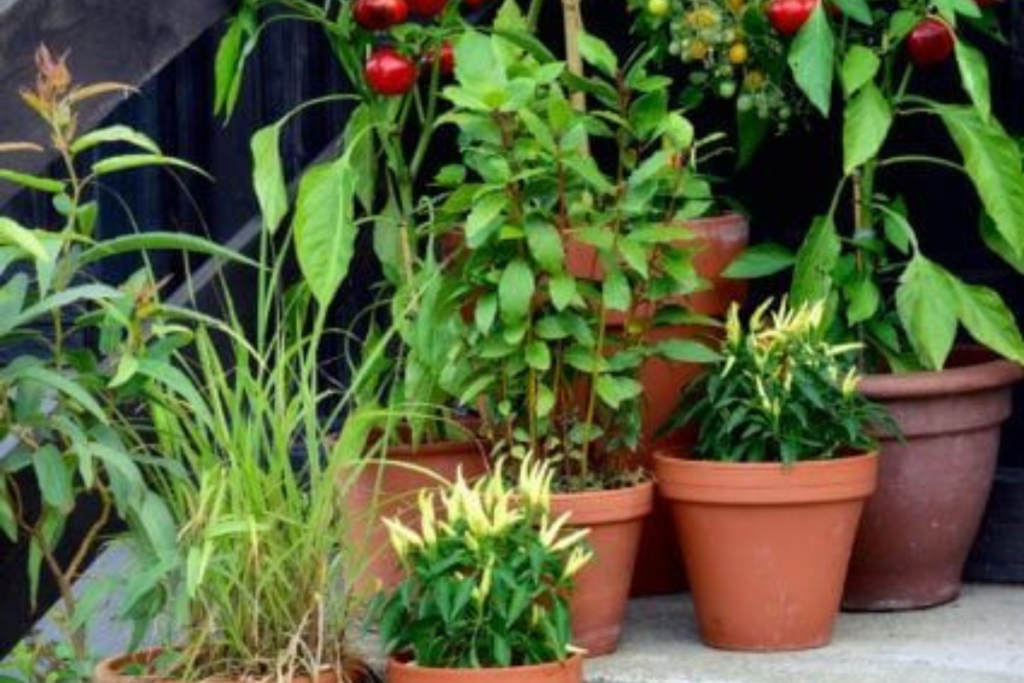Imagine stepping out onto your balcony, patio, or even just to a sunny windowsill and harvesting fresh tomatoes, herbs, or lettuce for your meal. Growing your own fresh produce in pots is not only rewarding but also an accessible way to enjoy healthy, homegrown food, no matter how much space you have. Here’s how you can start your very own potted garden and reap the benefits of fresh produce right at home.
Why Grow in Pots?

Potted gardening is perfect for those with limited outdoor space, such as apartment dwellers or urban homeowners. It’s flexible, portable, and allows you to create a thriving garden almost anywhere with sunlight. Additionally, pots let you control soil quality, drainage, and exposure to pests, making it easier to grow healthy plants.
Choosing the Right Pots
The type of pot you use is crucial for your plants’ health. Here are some tips to help you select the best containers:
- Size Matters: Larger pots are ideal for vegetables like tomatoes, peppers, and eggplants, which require deeper root systems. Smaller pots work well for herbs, lettuce, and radishes.
- Material: Terracotta, plastic, and fabric pots each have their benefits. Plastic retains moisture better, while terracotta provides a classic look but dries out quickly.
- Drainage: Ensure your pots have drainage holes to prevent waterlogging, which can lead to root rot.
Selecting the Best Produce to Grow
Not all fruits and vegetables thrive in pots, but many do exceptionally well. Here are some beginner-friendly options:
- Leafy Greens: Lettuce, spinach, and kale grow quickly and are perfect for small pots.
- Herbs: Basil, parsley, thyme, and mint are easy to grow and add flavor to your meals.
- Tomatoes: Cherry tomatoes are particularly well-suited for pots and produce abundant harvests.
- Peppers: Bell peppers and chili peppers thrive in pots with adequate sunlight.
- Root Vegetables: Carrots and radishes grow well in deep containers.
Preparing Your Pots
- Choose Quality Soil: Use a high-quality potting mix designed for vegetables and herbs. Avoid garden soil, as it can be too heavy and may not drain well.
- Add Nutrients: Mix in compost or slow-release fertilizer to ensure your plants get the nutrients they need.
- Set Up Proper Drainage: Place a layer of gravel or broken pottery at the bottom of the pot to improve drainage.
Planting and Maintenance
- Position for Sunlight: Most vegetables and herbs need 6-8 hours of sunlight daily. Place your pots in a location that receives ample light.
- Watering: Water your plants regularly, but don’t overwater. Check the soil moisture by sticking your finger about an inch into the soil—if it feels dry, it’s time to water.
- Fertilizing: Feed your plants every few weeks with a liquid vegetable fertilizer to promote healthy growth.
- Pruning: Remove dead or yellowing leaves to encourage new growth and keep your plants healthy.
Overcoming Challenges
- Pests: Keep an eye out for pests like aphids and caterpillars. Use organic pest control methods, such as neem oil or introducing beneficial insects like ladybugs.
- Temperature Fluctuations: Move your pots indoors or to a sheltered area during extreme weather conditions.
- Overcrowding: Avoid planting too many seeds in one pot, as overcrowding can stunt growth.
Harvesting Your Produce
One of the most satisfying moments in gardening is harvesting your produce. Pick herbs and leafy greens regularly to encourage continued growth. For vegetables like tomatoes and peppers, wait until they are fully ripe for the best flavor.
Benefits of Growing Your Own Produce
- Freshness: Nothing beats the taste of freshly harvested produce.
- Cost-Effective: Growing your own food can save you money on groceries.
- Sustainability: Reduce your carbon footprint by growing food locally.
- Health Benefits: Gardening is a great way to stay active and connect with nature.
Conclusion
Growing your own fresh produce at home in pots is a fulfilling and practical way to enjoy healthy food, even in small spaces. With a bit of planning, care, and patience, you can transform your home into a green oasis and savor the joy of homegrown goodness. So grab a pot, some seeds, and get started on your gardening journey today!
